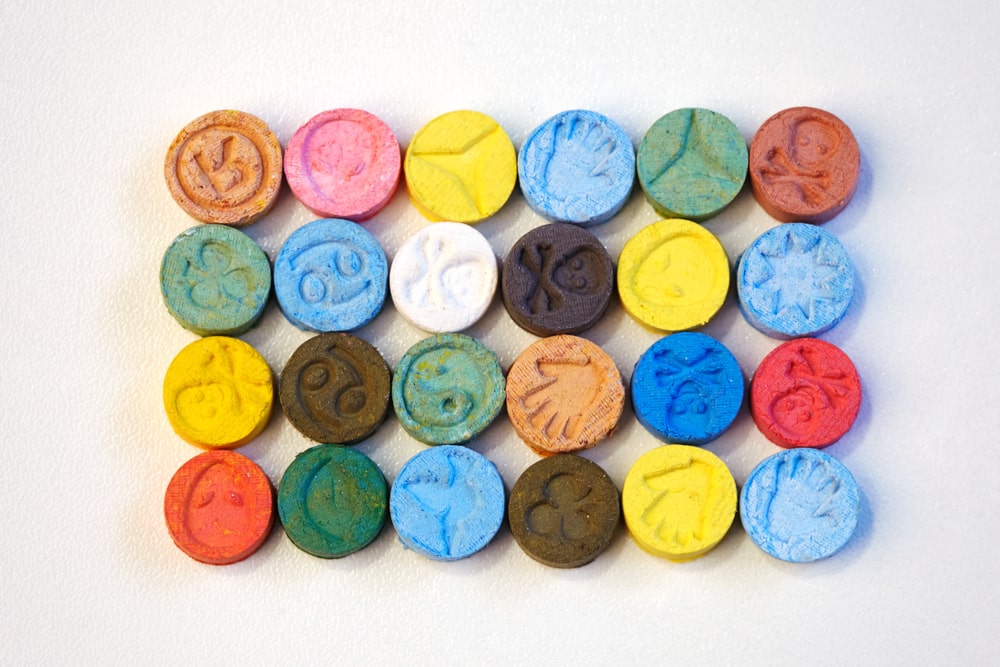Candyflipping is old news, but it’s still prevalent in the rave scene.
If you don’t know, candyflipping is when you mix MDMA with LSD.
Above: A group of ravers write reminders on their hands before candyflipping in Berkeley, California. (Via Flickr)
MDMA is also known as molly. The full name of the drug is 3,4-Methylenedioxymethamphetamine. It’s an empathogen or a drug that causes intense feelings of belonging and connectedness with other people.
LSD is another name for lysergic acid diethylamide or acid. Acid is a hallucinogen or a drug that makes you have altered perceptions. You might see, hear, or feel things that are outside of reality.
Together, molly and acid make each other’s effects more intense.
When you take molly after the acid reaches its peak, it can throw you back into the acid trip with the added effects of rolling on molly. You might have full-blown visuals while feeling intense euphoria.
If you’re thinking about candyflipping, you’re probably wondering if it’s safe. That’s a valid question since any substance can be more dangerous when you mix it with others.
Here’s what you should know about the risks of candyflipping:
Can You Die From MDMA?
It’s uncommon, but you can die from using MDMA. It’s more likely that you’ll have bad health effects (including overdose or death) if you:
- Have molly that’s tainted with fentanyl, meth, or other additives
- Re-dose molly too often or take a dose that’s too high
- Have a water or electrolyte imbalance
The United States government classifies MDMA overdoses as “psychostimulant overdoses.” Psychostimulants like molly make up 15% of drug overdose deaths in the United States.
Overdosing on Molly
Acid and molly are synergistic drugs. That means they increase each other’s effects, good and bad.
That does mean that you’ll have stronger euphoria and visuals, but it also means a greater chance for overdose.
Molly doses of higher than 80 to 120 mg are more likely to cause adverse effects. There are reports of death from between 120 and 750 mg doses.
Overall, it’s rare to overdose on molly, but possible. Overdosing on molly is likely if you:
- Have a heart condition
- Have an undiagnosed health condition
- Take pure MDMA (there was a 2014 report of a 15-year old girl dying 3 hours after taking 91% pure MDMA)
Tainted Molly
Only 13% of “molly” tested by the Drug Enforcement Agency contains any MDMA!
Instead, it’s common for molly pills to contain:
- Cathinones (“bath salts”)
- Mephedrone
- Methylone
- PMA (Paramethoxyamphetamine)
These drugs are all stimulants like molly, but they’re cheaper and harder to detect. That means drug manufacturers use these substances to cut their costs and fly under the radar.
Even though these drugs may have similar effects, they have lower toxic doses than MDMA. That can cause an accidental overdose because you don’t know what you’re ingesting. Taking a “safe dose” of molly doesn’t matter if the molly contains PMA; you could still overdose.
Rarely, molly can even contain fentanyl, a powerful opioid drug. This drug doesn’t mimic the effects of MDMA, but it causes intense euphoria. Fentanyl is deadly in tiny amounts, so it’s easy to overdose on it.
Water Intoxication and Molly
Rarely, people have died from water intoxication on molly. Water intoxication happens when you drink so much water that your body can’t process it.
When you’re rolling on molly, you’re sweating and losing water, sodium, and other electrolytes. Replacing that water without replacing the electrolytes can cause kidney damage, seizures, and death.
At the same time, people who use molly often do so at festivals or raves. That means lots of dancing and plenty of drinking water. At raves, there’s often signage reminding people to keep drinking water during their roll.
It is important to drink enough water, but it’s also important to pace your fluid intake.
If you drink more than a liter of water per hour while using molly, you can develop water intoxication. There are reports of death from drinking 10 to 20 liters of water over a few hours.
Can You Die From LSD?
There are no reports of people dying after using LSD alone. You could theoretically die after taking about 200 doses of LSD at once, but that’s never happened.
LSD and Poly-Drug Use
Any drug overdose death that happens under the influence of LSD was probably caused by another drug.
Poly-drug use is very common with LSD. Besides molly, people also combine acid with weed, opioids, stimulants, and research chemicals. Overdoses that involve acid aren’t usually caused by acid; they’re caused by the other drugs in the combo.
Tainted LSD
Like molly, there’s a possibility that street acid may not contain real LSD.
Instead, fake acid can include:
- Cathinones
- NBOMes (the most common one is 25I-NBOMe)
These are research chemicals commonly found in bath salts. They each have effects similar to both molly and acid, so many people candyflip with them without even realizing it.
The problem is, these research chemicals have a lower toxicity threshold. It doesn’t take a huge dose to cause an overdose.
The real danger is that you don’t know if you’re taking acid or NBOMes without a test kit. You might take a safe dose of “LSD” that turns out to be a lethal dose of NBOMes.
You can die from cathinones or NBOMes, but real LSD cannot cause an overdose death in any real-life doses.
Can You Die From MDMA and LSD Together?
There’s no proof that candyflipping causes more deaths than taking molly or acid alone. Still, we know that molly is synergistic with acid.
That means when you take molly and acid together, the effects are increased.
Molly has side effects that can include:
- Fever
- Heart palpitations
- High heart rate
- High blood pressure
- Vascular constriction
Mixing molly with acid can increase these effects. If you have an underlying circulatory condition, it could increase the risk of stroke, an acute heart condition, or other damage. This could lead to death, although there haven’t been reports specifically attributed to candyflipping yet.
Can You Die From Hippieflipping?
Many people who candyflip also hippieflip. Hippieflipping is the use of psilocybin mushrooms and molly together.
Some people consider hippieflipping a natural alternative to candyflipping. That’s because the mushrooms are naturally-occurring and obviously not research chemicals.
Mushrooms synergize less strongly with molly than acid. That means that the risk of increased side effects isn’t so dire.
As of 2020, there are no reports of deaths from hippieflipping.
Still, there are 2 risks:
- That you’ll misidentify the mushrooms: There are hundreds of small brown mushrooms in the United States that look like psilocybin species, but are actually toxic.
- That the MDMA isn’t really MDMA: Just like with candyflipping, there’s still a risk that your molly contains research chemicals or other drugs.
It is possible to die from fake molly if it contains the wrong drugs. And there are reports of deaths from ingesting naturally-occurring toxic mushrooms. Real psilocybin mushrooms can’t cause overdose or death, but it can be hard to tell the difference.
Is it an Overdose or a Bad Trip?
If you’ve never candyflipped before, you might think you’re having an overdose when it’s really just a bad trip.
A bad trip can be the result of:
- Not controlling your “set and setting”, or the environment and your mindset when you take drugs
- Taking a dose that’s too high
- Combining the wrong drugs
- Taking drugs that aren’t what you think they are, such as cathinone that you bought as molly
You may feel anxious, panicky, or hopeless during a bad trip, but it’s only temporary. Some people see nightmare visuals or get stuck in thought loops on LSD during a bad trip.
This can be scary, but it’s not an overdose. Bad trips pass within 6-12 hours for acid. If you’re candyflipping, then it could last longer. The time range varies depending on the drugs.
What Are the Signs of an Overdose on MDMA and Psychedelics?
The signs of an overdose while candyflipping include:
- Coma
- High fever
- Problems breathing
- Seizures
Most overdoses are either caused by research chemicals (e.g. your molly wasn’t actually MDMA) or re-dosing too much MDMA.
It’s rare to overdose on MDMA unless it’s tainted, but if it happens, call 911 right away.
Can You Candyflip Safely?
It’s better to avoid candyflipping due to the possible bad side effects. Still, the biggest danger with candyflipping is the possibility of tainted molly or acid.
Tainted drugs increase the odds of an overdose or a bad experience.
If you’re going to use molly or acid despite the risks, you should:
- Test your drugs using a reagent test kit, which you can find online
- Use small doses and don’t re-dose, especially with MDMA
- Know how to spot an overdose, including high body temperature, seizures, or blacking out
- Drink water to avoid getting dehydrated, which can increase the risk of a hospital visit
- Never mix acid and molly alone, always have a sober trip sitter with you
Get Treatment for Polysubstance Abuse
If you’re worried that mixing substances is affecting your life, you’re not alone. Millions of Americans suffer from polysubstance abuse each year.
You can be free from substance use. Even though psychedelic drugs aren’t addictive, the drugs you mix them with can be. And psychological addiction can happen without physical dependence.
To get help with polysubstance abuse, contact an addiction treatment center today. If you aren’t sure which treatment center(s) to call, look through our directory to find the nearest addiction treatment center near you.
Sources
- DrugFacts: MDMA (Ecstasy/Molly) (June 2018)
- LSD and MDMA: What to Know About Candyflipping (February 2, 2020)
- Candyflipping and Other Combinations: Identifying Drug–Drug Combinations from an Online Forum (April 30, 2018)
- Drug Overdose Deaths Involving Cocaine and Psychostimulants (2019)
- MDMA (Molly/Ecstasy) Dosage (n.d.)


